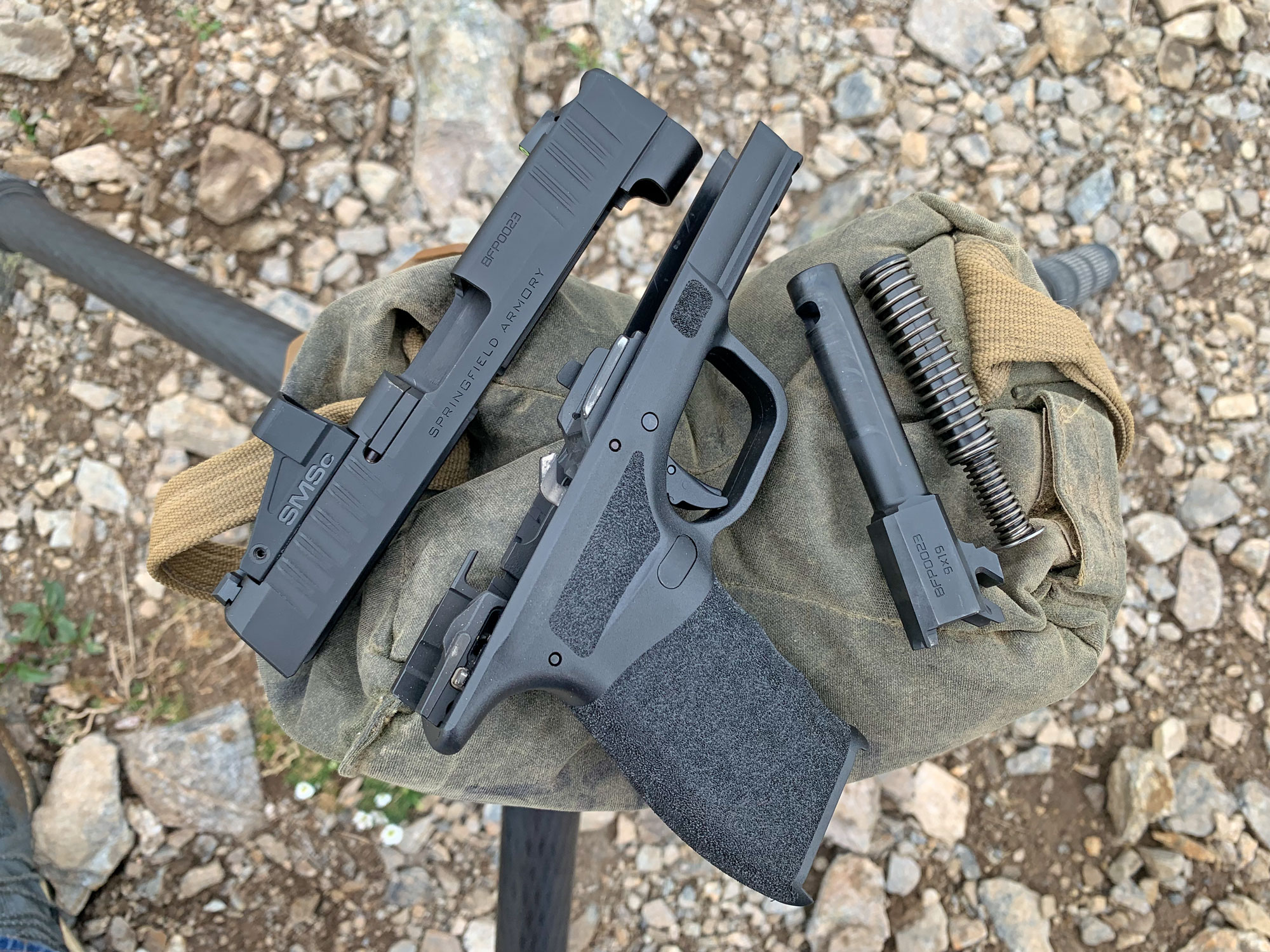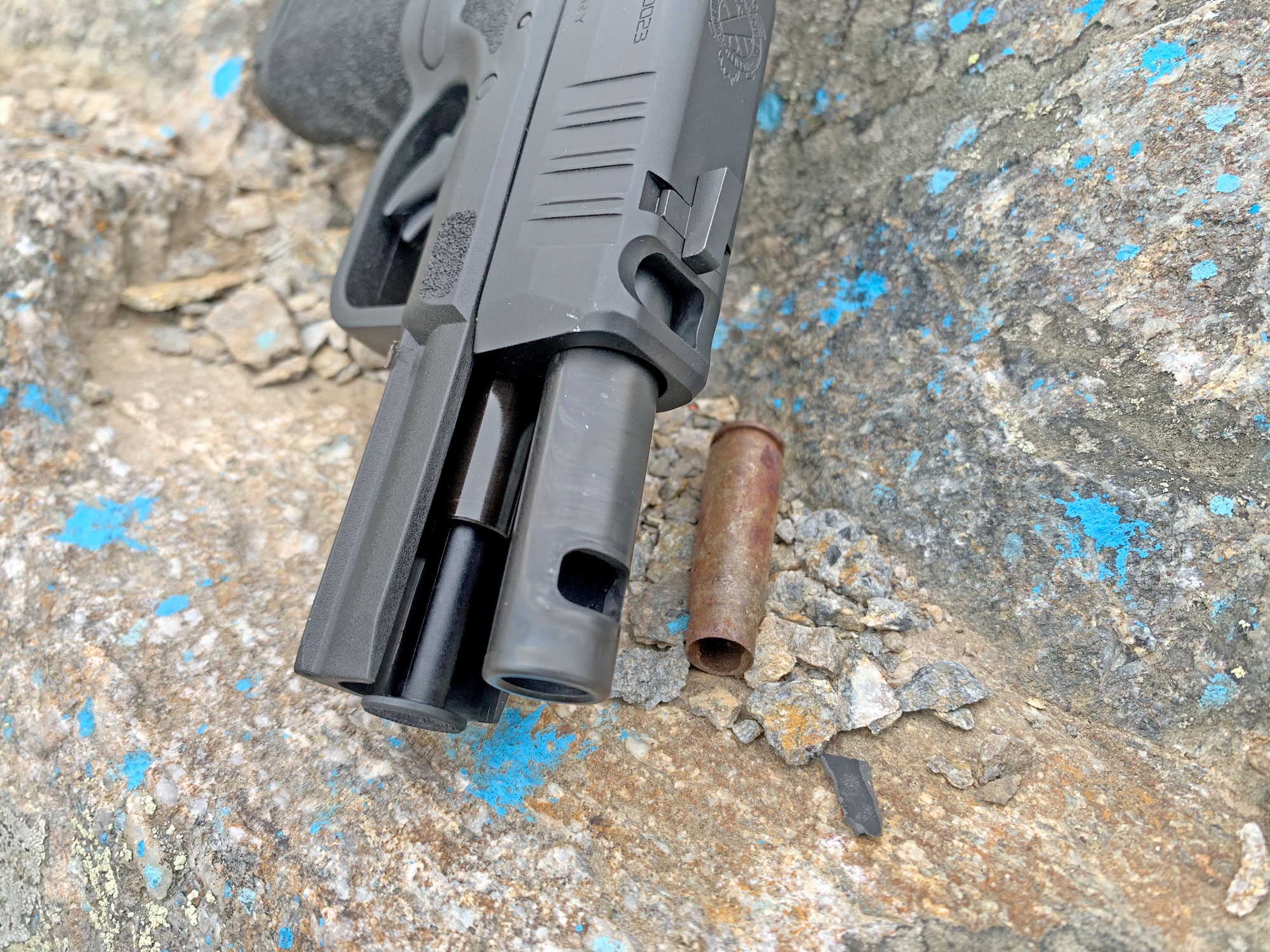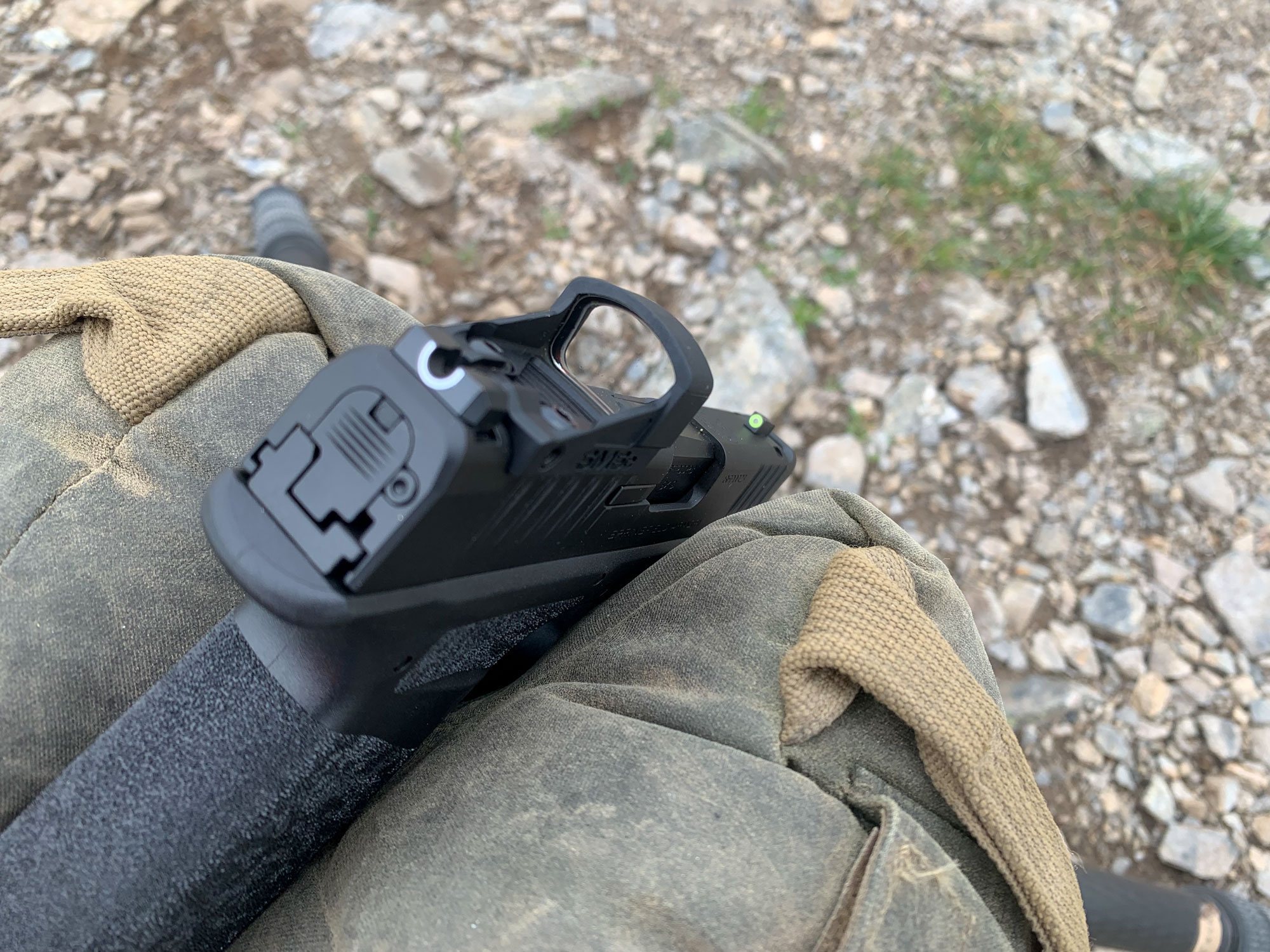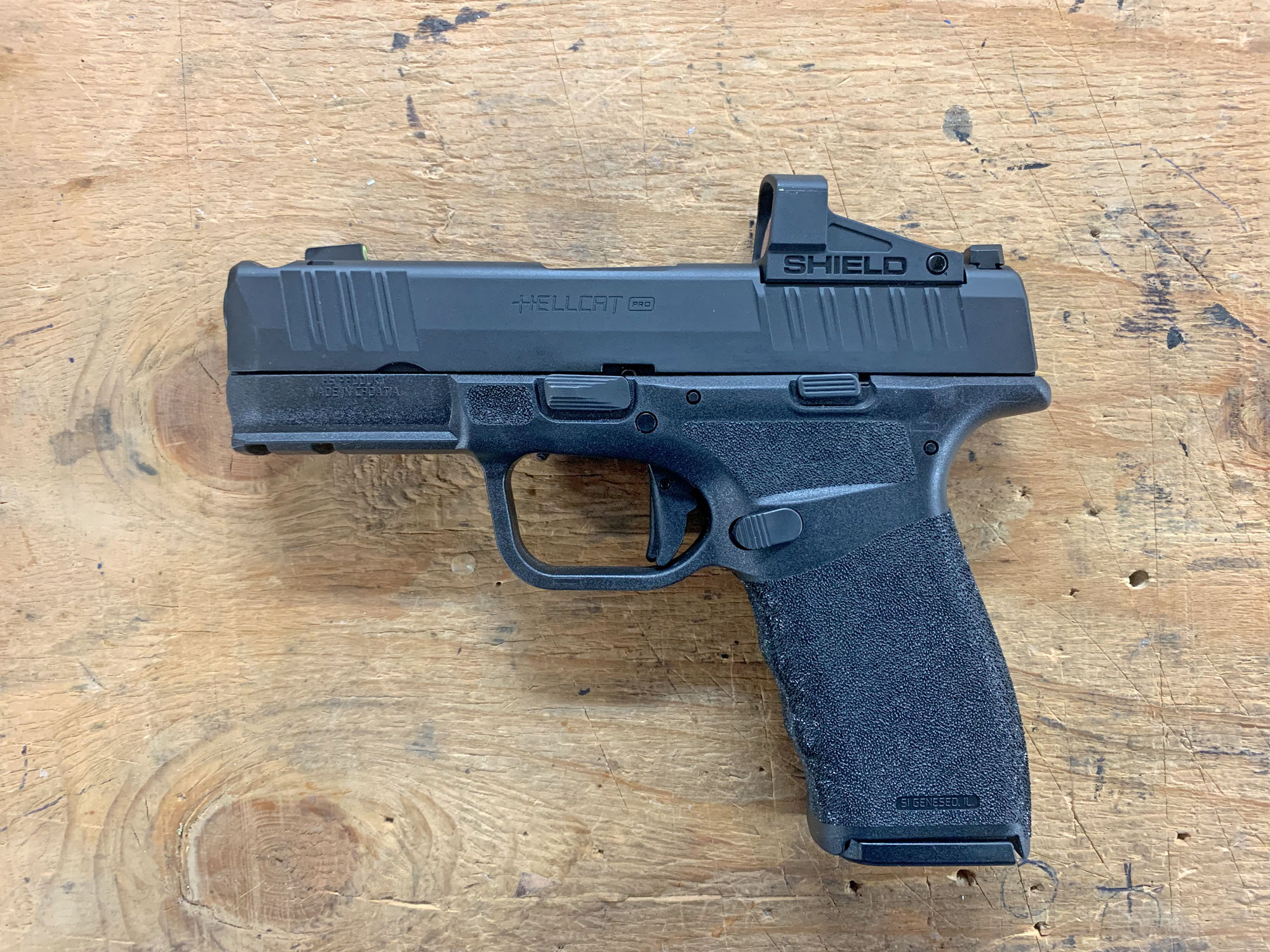Springfield’s popular Hellcat pistol has become one of the most dominant micro-compact 9mm handguns in its peer group. It’s pint sized, but boasts previously unprecedented capacity and wonderful shootability. The standard Hellcat was only the first step though, and as we’ve seen with other flagship micro-compacts, the engineers at Springfield have shaped and massaged the platform into an even more ideal concealed carry gun. I’ve shot numerous Hellcats and Hellcat Pro pistols, and I didn’t expect the Springfield Hellcat Pro Comp to be much different — I was dead wrong.
Springfield Hellcat Pro Comp OSP Specs
See It
- Caliber: 9mm
- Capacity: 15+1 or 17+1
- Magazine Material: Steel
- Dimensions: 4.8 inches (H) x 6.6 inches (L) x 1 inch (W)
- Weight: 1 pounds, 4 ounces (weighed with empty 15-round magazine and optic)
- Frame: Polymer
- Slide: Steel, black Melonite finish
- Grip: Fine stipple pattern
- Barrel: 3.7 inches, Melonite finish, integrated compensator
- Sights: Tritium front dot, U-notch rear
- Optic ready: Yes, RMSc footprint (Shield SMSc optic used)
- Trigger: Single-action, 6 pounds, 10 ounces (measured)
- Safety: Trigger safety bar
- Price: $600
Key Features
- Integral slide/barrel compensator
- RMSc optic footprint
- Subtle-but-grippy stipple texture
- Low-profile controls and slide serrations
- Accuracy average: 1.809 inches (13 five-shot groups at 15 yards)
Review Highlights
- Dramatically reduced recoil impulse
- Excellent capacity
- Retains good concealability
- Easily co-witnessable iron sights
- Heavy trigger
What’s the Hellcat, and What Makes the Springfield Hellcat Pro Comp Different?
The micro-compact 9mm pistol market was just beginning to bloom when Springfield introduced the 3-inch-barreled Hellcat in late 2019. To date, the most significant and similar competitor in the space is the Sig P365, which was launched the previous year. Like the P365, the Hellcat is a polymer-framed, striker-fired 9mm pistol that crams 13 rounds of ammo in its tiny magazine. This was earth-shaking, as pistols of this size typically topped out at 8 rounds of ammo.
This new pistol was reliable, ultra concealable, and had a grip texture that provided secure traction but wasn’t too abrasive. Low-profile controls, front and rear cocking serrations, and good iron sights added to the utility. The only drawback of the design was (and is) in how the recoil impulse is directed back into the shooter’s hand. The Hellcat pistols universally have sharper, snappier recoil than most similarly sized blasters — though it’s still manageable.
Evolution of the Hellcat
Following the success of the regular Hellcat, Springfield launched the Hellcat RDP in 2020, which was equipped with a Hex Wasp red dot and a threaded muzzle topped with a self-timing compensator. Though the original Hellcats were offered with only iron sights, the OSP (optical sight pistol) models quickly stole the show — corresponding with a sweeping movement toward using red dots on EDC pistols.
In 2022, we got our look at the Hellcat Pro OSP, a slightly up-sized model. By using a slightly longer 3.7-inch barrel and longer grip, they created an even more stable platform with higher capacity while maintaining great concealability. The Pro OSP an ultra-slim, subcompact pistol that can hold 15+1 or 17+1 rounds — the same as classic compact and full-sized pistols like the Glock G19 and G17. Sig has done similar with the larger P365 XL and P365 XMacro pistols.

The Springfield Hellcat Pro Comp
Latest in the Hellcat family, the Hellcat Pro Comp’s defining feature is an integral compensator. The pistol still sports the 3.7-inch barrel — though only about 3.2 inches of it is a functional rifled barrel — with a compensator built into the barrel itself. Initially I rolled my eyes at this development, thinking this would be either a simple barrel porting, or a shorter barrel and half-assed compensator in the front of the slide. A critique I have on some of the integrally compensated Sig P365s is that the slide compensators don’t seem to do much work with 9mm. In fact, while shooting the P365 XMacro and XMacro Tacops (compensated and uncompensated) side by side, I couldn’t tell much difference in recoil impulse or muzzle flip.
The compensator on the Springfield Hellcat Pro Comp is different though. It’s a compensator milled directly into the front half inch of the barrel itself. The slide and barrel both have a rectangular port in the top, but on close examination, you’ll see that the rifling terminates at the porting, and a portion of the barrel steel is hogged out of the inside, creating a blast chamber that directs gasses upward.
Shooting alongside the non-ported Springfield Hellcat Pro with a 4.7-inch threaded barrel, the difference in muzzle flip and reduction of the characteristically sharp recoil impulse was flabbergasting — particularly with 115- and 124-grain +P loads. While driving the pistol hard and fast, I could keep the red dot on target without ever being blown out of my sight picture by the recoil.

Standard Hellcat Pro OSP Features
If you’re familiar with the Hellcat, most of the features on this new gun are repetitious. Each model typically incorporates one or two defining features that optimize it in some way — The Springfield Hellcat Pro Comp is no different.
Aside from the compensator, the optic mounting and compatibility is most significant. I got the model that includes a Shield SMSc, but the RMSc footprint is compatible with a variety of optics. What’s nice about the SMSc and low optic cut is that the standard low-profile factory irons that Springfield fits the guns with are easily co-witnessable through the optic — something that the larger pistols like the XD-M can’t claim.
All controls are low profile and won’t snag on holsters or clothing, and they are decidedly right-handed. Though the rotating takedown lever and slide stop lever don’t protrude very far, they aren’t difficult to operate, and the only drawback is that the slide stop lever is a bit sharp on the thumb.
The original Hellcat used 13-round magazines, the Hellcat Pro Comp comes with one each 15- and 17-round magazine. The 15-round magazine fits flush with the base of the grip, and the 17-rounder is capped with a textured extension that sticks out just below the frame. Even when packing a 17+1 loadout, the Hellcat is still less obtrusive than a regular compact pistol like a Glock G19.

Springfield Hellcat Pro Comp OSP Accuracy
The Hellcat Pro Comp made quite an impression with how well it shot in a practical sense. The reduction in recoil impulse and muzzle flip greatly increased control, but initially, it didn’t wow me with accuracy. To test accuracy, the Outdoor Life standard protocol is to record 5-shot groups from 15 yards, fired from a standing position with two-hands, braced on a bagged tripod.
When testing ammo like Hornady’s 115-grain Critical Defense and Remington’s 124-grain Golden Sabre, which were wonderful from a functional standpoint, I was seeing below-average accuracy. Most pistols of the style will print groups under 2.5 inches with 1.5 inches being quite good. Each group I fired had shots that stretched it to three or four inches — even with 125-grain Staccato Match ammo.

A Funky Trigger
I had been firing at my normal cadence for the task, but decided to shoot as carefully as I possibly could. I really had to fight the trigger on the Hellcat, but with great care I managed to reduce my average group size to 1.451 inches with the Staccato Match ammo.
The highest hurdle for accuracy with this pistol is its stiff trigger, which has a relatively long and uneven pull. When taking up the trigger, it peaks at nearly 7 pounds, then still has significant backward travel before breaking. Cracking clean shots requires tremendous concentration to slowly press through that additional movement. At my regular pace, I was shanking shots far to the left of where they should have been. While running and gunning, the stiff trigger isn’t isn’t too noticeable, but if you’re trying to break careful, precise shots, the trigger shoe itself is a bit painful.
I’d like to see a crisper break and a shorter, more tactile reset.
Final Thoughts: The Springfield Hellcat Pro Comp OSP is A Great Concealed-Carry Gun
Line extensions often aren’t too exciting, but the simple integrated compensator on this new Springfield Hellcat is notable. One of the most important attributes of a concealed-carry gun is its shootability. Can you shoot it accurately under stress and stay on target? That’s quite a bit easier with this iteration of the platform. Along with that leading-edge feature, it brings great concealability, capacity, and ergonomics. Additionally, it’s a well-supported platform with lots of options for holsters that will fit your needs. Is the Springfield Hellcat Pro Comp the most dramatic gun introduction we’ve seen recently? No. But it’s taken a solid, successful platform and made it even better. That’s worth getting a little excited about.
Read the full article here




